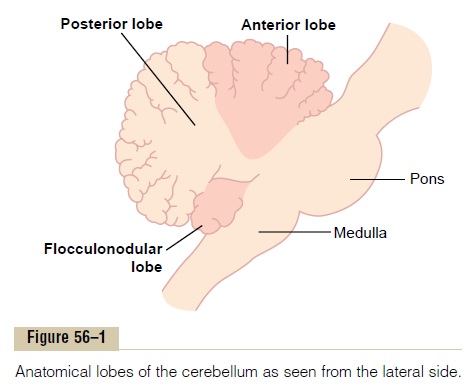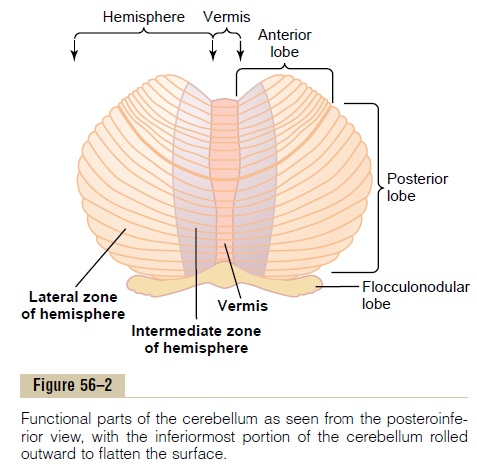Chapter: Medical Physiology: Contributions of the Cerebellum and Basal Ganglia to Overall Motor Control
Cerebellum and Its Motor Functions
Cerebellum and Its Motor Functions
The cerebellum, illustrated in Figures 56–1 and 56–2, has long been called a silent area of the brain, principally because electrical excitation of the cerebel-lum does not cause any conscious sensation and rarely causes any motor movement. Removal of the cerebellum, however, does cause body movements to become highly abnormal. The cerebellum is especially vital during rapid mus-cular activities such as running, typing, playing the piano, and even talking. Loss of this area of the brain can cause almost total incoordination of these activi-ties even though its loss causes paralysis of no muscles.

But how is it that the cerebellum can be so important when it has no direct ability to cause muscle contraction? The answer is that it helps to sequencethe motor activities and also monitors and makes corrective adjustments in the body’s motor activities while they are being executed so that they will conform to the motor signals directed by the cerebral motor cortex and other parts of the brain.

The cerebellum receives continuously updated information about the desired sequence of muscle contractions from the brain motor control areas; it also receives continuous sensory information from the peripheral parts of the body, giving sequential changes in the status of each part of the body—its position, rate of movement, forces acting on it, and so forth. The cerebellum then com-paresthe actual movements as depicted by the peripheral sensory feedbackinformation with the movements intended by the motor system. If the two do not compare favorably, then instantaneous subconscious corrective signals are transmitted back into the motor system to increase or decrease the levels of activation of specific muscles.
The cerebellum also aids the cerebral cortex in planning the next sequential movement a fraction of a second in advance while the current movement is still being executed, thus helping the person to progress smoothly from one movement to the next. Also, it learns by its mistakes—that is, if a movement does not occur exactly as intended, the cerebellar circuit learns to make a stronger or weaker movement the next time. To do this, changes occur in the excitability of appro-priate cerebellar neurons, thus bringing subsequent muscle contractions into better correspondence with the intended movements.
Related Topics